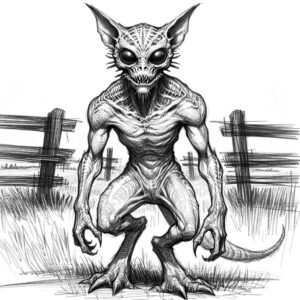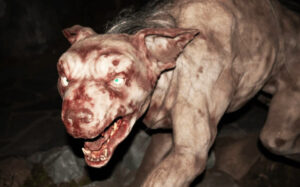Table of Contents
Deep in the heart of Latin America, a sinister legend lurks in the shadows, striking terror into the hearts of rural communities. Transitioning to the enigmatic being known as El Chupacabras, a name that sends shivers down the spine. This mythical creature has gripped the imaginations of many, leaving behind a trail of fear and mystery.
Origins and Name

The origins of El Chupacabras can be traced back to the late 20th century, primarily in Puerto Rico. The name “Chupacabras” is Spanish for “goat-sucker,” a direct reference to its alleged habit of drinking the blood of livestock, particularly goats. The first reported encounters with this creature occurred in the early 1990s, when farmers and rural dwellers began to describe gruesome scenes of their animals mysteriously drained of blood.
El Chupacabras is a loner by nature, rarely if ever seen in the company of others of its kind. It is not known to have a family structure in the conventional sense. Rather, it is often described as a solitary and elusive predator that prowls the night, searching for its next victim.
Appearance
Descriptions of El Chupacabras vary, but a few common traits emerge from eyewitness accounts. It is typically described as a small, humanoid creature standing around 3 to 4 feet tall. Its skin is said to be gray or greenish, wrinkled, and scaly, reminiscent of a reptile. Large, red, glowing eyes are a consistent feature in these accounts, adding to the creature’s eerie and otherworldly appearance.
El Chupacabras is known for its sharp, fang-like teeth, which it uses to puncture its victims and extract their blood. Its fingers end in claws, perfect for grasping and immobilizing its prey. Some accounts even claim it has wings, allowing it to move swiftly and silently through the night.
Abilities

The most notorious ability of El Chupacabras is its proficiency at draining the blood of livestock, particularly goats and chickens. It is believed to strike with surgical precision, leaving behind only small puncture wounds on its victims. The blood-draining aspect is the hallmark of its legend, and it’s this trait that has struck fear into the hearts of rural communities.
El Chupacabras is also known for its elusiveness and ability to evade capture. It is said to move swiftly and silently, disappearing into the darkness before witnesses can react. This supernatural agility adds to the mystique surrounding the creature.
Symbols
Unlike many mythical creatures that have distinct symbols associated with them, El Chupacabras lacks a clear set of symbols or icons. However, its name, which translates to “goat-sucker,” has become a symbol in itself, conjuring images of livestock drained of blood.
Related Myths and Stories

El Chupacabras has been the subject of numerous myths and stories, often fueled by sensationalized media reports and local folklore. Here are a few notable ones:
The Puerto Rican Origins
In the early 1990s, the legend of El Chupacabras emerged with dramatic intensity in Puerto Rico. During this time, a wave of fear gripped the island as reports of mysterious livestock deaths began to circulate. Consequently, this unexplained phenomenon ignited widespread panic and hysteria among the local population.
Moreover, the reported livestock killings were characterized by a gruesome and eerie pattern. Animals, primarily goats and chickens, were discovered with their blood mysteriously drained, leaving behind small puncture wounds as the only evidence of the gruesome encounters.
As fear escalated rapidly, word of these incidents spread throughout the island, creating a palpable sense of dread among the population. Families were on edge, and the simple act of tending to livestock became fraught with anxiety.
To address these concerns, communities banded together in an effort to protect their animals. People employed various tactics to safeguard their livestock, including locking them in secure enclosures and keeping vigilant watch during the night. Meanwhile, local authorities were inundated with reports and requests for assistance, but the elusive nature of El Chupacabras made it nearly impossible to catch.
In the midst of this crisis, the media played a pivotal role. Sensationalized reports and eyewitness accounts not only fueled public fear but also contributed to the growing belief in the existence of this mysterious creature. The media’s portrayal of El Chupacabras only served to deepen the sense of dread and unease among the population.
The lasting impact of this phenomenon on Puerto Rican culture and folklore cannot be overstated. To this day, it remains a subject of fascination, fear, and intrigue. While some have dismissed the phenomenon as mass hysteria or the result of natural predators, the events of the early 1990s continue to be a chilling chapter in the island’s history.
Global Sightings

While the phenomenon began in Puerto Rico, similar reports of livestock mutilations and blood-draining incidents soon surfaced in other Latin American countries, the United States, and even parts of Europe. The legend of El Chupacabras had gone global, instilling fear and curiosity in people worldwide.
Pop Culture Impact
El Chupacabras has made its mark in popular culture, appearing in various books, movies, and television shows. It often serves as a symbol of fear of the unknown and the unexplained.
Movies
“Chupacabra Terror” (2005). This horror film revolves around a group of people who encounter El Chupacabras while on a remote island. As they fight for survival, they must contend with the mysterious and deadly creature.
“Chupacabra vs. the Alamo” (2013). In this made-for-TV movie, El Chupacabras becomes the antagonist as it terrorizes residents of San Antonio, Texas. It’s up to a group of brave individuals to confront the creature.
“The Chupacabra: Dark Seas” (2005). This movie combines elements of horror and science fiction as a cargo ship’s crew encounters the legendary Chupacabras while at sea. The creature wreaks havoc on board, leading to a desperate battle for survival.
Literature
“The Beast of Bray Road: Tailing Wisconsin’s Werewolf” by Linda S. Godfrey: While primarily focused on the “Beast of Bray Road,” this book also delves into El Chupacabras and its presence in cryptozoological lore.
“Monsters of Texas” by Ken Gerhard: This book explores various cryptids, including El Chupacabras, that have been reported in Texas. It provides a comprehensive overview of the creature’s sightings and encounters in the region.
Cryptozoology
The study of unknown or hidden animals, known as cryptozoology, has taken an interest in El Chupacabras. Researchers and enthusiasts continue to investigate sightings and reports in the hope of shedding light on this elusive creature’s existence.
Historical Perspective: Cryptozoology has a long history, with early explorers and naturalists documenting accounts of mysterious and undiscovered creatures. In the case of El Chupacabras, the modern era of cryptozoology took off in the early 1990s when reports of livestock deaths began to circulate in Puerto Rico.
Field Investigations: Cryptozoologists and researchers interested in El Chupacabras have conducted field investigations in regions where sightings have occurred. These investigations typically involve interviewing eyewitnesses, examining physical evidence (such as photos or videos), and studying the circumstances surrounding alleged encounters.
Analysis of Evidence: Researchers scrutinize the evidence provided by witnesses, looking for patterns or consistencies in reported sightings. They seek to differentiate between potential hoaxes, natural predator behavior, and genuinely unexplained incidents.
Local Lore and Folklore: Cryptozoologists also delve into the local folklore and legends associated with El Chupacabras. They investigate the cultural context and historical accounts to gain a deeper understanding of the creature’s origins and the beliefs surrounding it.
Possible Explanations: While some cryptozoologists remain open to the possibility of an undiscovered species or paranormal entity, others approach the phenomenon with skepticism. They often explore alternative explanations, such as misidentified animals, wild dogs or canids with unusual behavior, and the effects of mass hysteria.
Scientific Scrutiny: It’s essential to note that mainstream science generally remains skeptical of cryptozoology and cryptid claims. For many scientists, conclusive evidence is required before recognizing the existence of a new species. Cryptozoologists, however, argue that the absence of evidence does not necessarily equate to evidence of absence and continue their investigations.
Similarities
El Chupacabras, often characterized by their bloodsucking or predatory nature, shares similarities with various creatures. Here are a few examples:
Transitioning to the first example, Vampire. Found in various cultures worldwide, vampires are known for their thirst for blood and nocturnal activities. They often have sharp fangs and are considered undead.
Moving on to the next example, Lamia. In Greek mythology, Lamia was a female demon who sucked the blood of children. She was often depicted as having a serpent-like lower body.
Transitioning to the following example, Incubus/Succubus. These male and female demons, respectively, were believed to seduce and drain the life force or blood of their victims in folklore from various cultures.
Moving on to the next example, let’s explore “Lugaru” or “Rougarou.” Originating from Cajun and French-Canadian folklore, the Lugaru is a shapeshifter with a wolf-like appearance, renowned for its predatory inclinations towards both livestock and, at times, humans.
Transitioning to another example, Vetala. In Hindu mythology, the Vetala is a revenant spirit known for inhabiting and animating dead bodies, occasionally depicted as a blood-drinking entity.
Aswang. From Philippine folklore, the Aswang is a shape-shifting monster known for its ability to transform into various creatures, including vampires and predatory animals. It preys on humans and livestock.
FAQ
Where does the legend of El Chupacabras come from?
The legend of El Chupacabras first gained prominence in Puerto Rico during the early 1990s when reports of mysterious livestock deaths circulated, sparking fear and fascination.
What does the name "Chupacabras" mean?
"Chupacabras" is a Spanish term that translates to "goat-sucker," alluding to the creature's supposed habit of drinking the blood of goats.
What does El Chupacabras look like?
Descriptions vary, but common features include gray or greenish scaly skin, large red or glowing eyes, fang-like teeth, and sometimes wings. It's often depicted as a small, humanoid creature.
Does El Chupacabras exist?
The existence of El Chupacabras remains unproven by mainstream science. While there have been many reported sightings and encounters, no conclusive evidence has confirmed its existence.
What regions have reported El Chupacabras sightings?
Sightings and reports of El Chupacabras have been documented in various parts of Latin America, the United States, and even Europe, although Puerto Rico is considered its epicenter.
What impact has El Chupacabras had on popular culture?
El Chupacabras has been the subject of movies, TV shows, books, and folklore, making it a significant part of cryptid and urban legend lore.
Is there ongoing research on El Chupacabras?
Cryptozoologists and enthusiasts continue to investigate sightings and reports of El Chupacabras in the hope of shedding light on its existence, but mainstream science remains skeptical.
Could El Chupacabras be explained by natural predators?
Some believe that reported livestock killings attributed to El Chupacabras may be the result of natural predators or wild dogs. Skeptics argue that it could be a case of misidentification.
Is El Chupacabras dangerous to humans?
There are no documented cases of El Chupacabras attacking humans. Its alleged victims are primarily livestock, leading to economic concerns for farmers.



